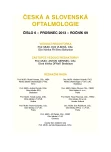Evaluation of the Clinical Results of Implantation the Hydrophobic-hydrophilic Intraocular Lens ERIFLEX 877 FAB
Authors:
A. Stepanov; N. Jirásková; J. Nekolová; J. Lackovič; J. Románek; P. Rozsíval
Authors‘ workplace:
Oční klinika, Fakultní nemocnice, Hradec Králové, přednosta prof. MUDr. Pavel Rozsíval, CSc., FEBO
Published in:
Čes. a slov. Oftal., 69, 2013, No. 6, p. 236-238
Category:
Original Article
Práce byla přednášena na XIX. výročním kongresu České a Slovenské oftalmologické společnosti, Brno, 26. října 2013
Overview
Purpose:
To evaluate the properties of intraocular lens ERIFLEX 877 FAB, the manipulation during implantation and clinical outcomes after implantation of the new hydrophobic-hydrophilic intraocular lens in patients undergoing routine cataract surgery.
Material and Methods:
The study included 30 patients (38 eyes), mean age 71 ± 8 years (range 53–89 years) with senile cataract. After phacoemulsification intraocular lens ERIFLEX 877 FAB was implanted. Patients were evaluated at 3 months after surgery. We assessed the uncorrected visual acuity (UCVA) and best corrected visual acuity (BCVA), refraction, keratometry and the incidence of posterior capsule opacification (PCO - Posterior capsule opacification). Individual patient’s and surgeon’s satisfaction was also documented including manipulation during surgery.
Results:
Three months after surgery, the mean UCVA was 0.7 ± 0.2 and BCVA was 0.97 ± 0.16. PCO value was 0.15 ± 0.09, that means minimal incidence of PCO. Good UCVA and a minimal incidence of PCO have resulted in a high degree satisfaction of patients.
Conclusion:
The new hydrophobic-hydrophilic intraocular lens ERIFLEX 877 FAB could be easily implanted and after surgery shows a high degree of biocompatibility in patients undergoing routine cataract surgery.
Key words:
intraocular lens ERIFLEX 877 FAB, posterior capsule opacification, OSCA
Sources
1. Aslam, T., Niall, P., Christopher, R.: OSCA: a comprehensive open-access system of analysis of posterior capsular opacification, BMC Ophthalmology, 2006; 6 : 30.
2. Pozlerová, J., Nekolová, J., Jirásková, N., et al.: Hodnocení opacit zadního pouzdra u různých typů umělých nitroočních čoček. Čes a slov Oftal, 2009; 65(1): 12–15.
3. Jirásková, N., Rozsíval, P.: Metody hodnocení zkalení zadního pouzdra po operaci katarakty. Čes a slov Oftal, 2004; 60(2): 155–157.
4. Žemaitiené, R., Jašinskas, V., Barzdžiukas, V. et al.: Prevention of posterior capsule opacification using different intraocular lenses (result of one-year clinical study). Medicina (Kaunas), 2004; 40(8): 721–729.
5. Werner, L.: Calcification of hydrophilic acrylic intraocular lenses. Am J Ophthalmol., 2008; 146 : 341–343.
6. Kato K., Nishida, M.,Yamane H. et al.: Glistening formation in an AcrySof lens initiated by spinodal decomposition of the polymer network by temperature change. J Cataract Refract Surg, 2001; 27 : 1493–1498.
Labels
OphthalmologyArticle was published in
Czech and Slovak Ophthalmology

2013 Issue 6
Most read in this issue
- Vision Loss after Uncomplicated Pars Plana Vitrectomy
- Treatment Strategy of the Lacrimal Drainage System Inborn Obstruction. Part One – Conservative and Intervention Procedures
- Cytomegalovirus Retinitis in HIV Negative Patients – Retrospective Study
- Pars Plana Vitrectomy Due to the Intravitreal Hemorrhage Caused by Persistent Hyaloid Artery in Three Children
